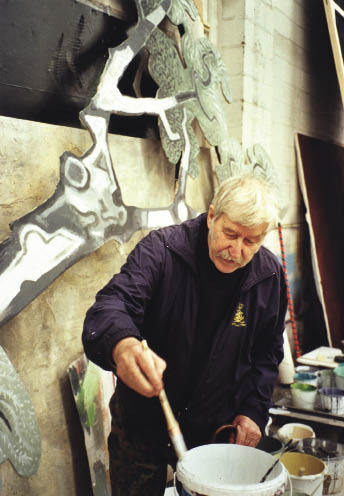Last year, within the space of five weeks before Christmas, I lost two friends who had illumined the world for me and made it a more enlivening place. Both were artists, both were in their eighties and both were determined individualists who recognised each other’s work without being in any way close allies. John Craxton was the first to die, in hospital on 17 November after a short illness. Just over a month later, Craigie Aitchison dropped dead of a heart attack. I hope to write about Aitchison when some of his distinctive work on the theme of the Crucifixion is on show. This is a tribute to John Craxton.
An artist with a particular interest in the inhabited landscape, Craxton could summon up the spirit of place with a wit and ingenuity that left most painters of his generation standing. Aware from youth that there is no art without other art, he sought out essence rather than originality, but achieved an original vision by the depth of his understanding and interpretation. John detested labels and pigeonholes, principally because they encouraged unjustified assumptions and lazy thinking, and he is frequently quoted as disliking the term ‘neo-romantic’, which was attached to his own work of the 1940s. It was the ‘neo’ he objected to particularly, being proud to admit his indebtedness to the Romantic vision of William Blake and Samuel Palmer, just as he would be the first to claim the inspiring influence of Byzantine art.
Bryan Robertson, the brilliant director of the Whitechapel Gallery who gave Craxton a retrospective in 1967, noted the enduring appeal of John’s work — its qualities of clarity, incisiveness and abstraction. He wrote:
Robertson made the point that Craxton painted only for pleasure and did not seek out a public career — so much so that in later years I would encounter many an art lover who thought him already dead because he was visible so little on the exhibiting circuit. In fact, he spent much of his time in Crete, and had long before reached the firm decision that life was indisputably more important than art, that in fact life (in Noël Coward’s words) was for living.
This was a revolutionary position to take up in the outwardly dedicated art world. The artist is supposed to be utterly committed to his art, with no time for the distractions of social life or extra-curricular activities, the contemporary model for this being Frank Auerbach or Lucian Freud. Craxton begged to differ, delighting in the art of conversation (at which he was a past master), travel (often by motorbike), parties (grand or impromptu), food and all the many possible seductions that others might dismiss as time-wasting but which he regarded as time well spent. He knew how to enjoy life, and in the process he enriched countless other lives as well as his own. Who is to say that the wealth of knowledge and experience he derived from living, and which he dispensed to friends and acquaintances with a liberal hand, was not equally as valuable as his more visible and tangible legacy, his paintings?
It is often maintained that Craxton’s work declined from its early eminence, that he never fulfilled the promise of his evident talents. I think he did, but he chose not to channel it simply into his art, he diversified his genius into his life. Not everyone has the gift of being happy, but he did, and he offered his own happiness to others. There is perhaps a lesson here.
John’s memorial service took place at St James’s Church in Piccadilly. Craxton was probably a pagan, or an Arcadian as he would have preferred, but like most interesting people he was a bundle of contradictions, so a church service with hymn and prayers was not in fact inappropriate. Craxton was very English: he observed the forms of society, finding it unnecessary to flaunt his homosexuality or his artistic nature — preferring to save his powder for something more important. He would grow incensed about the treatment of art or individuals, the disrespect with which our society treated something or someone he held dear. In Crete, his own Arcadia, he shook his stick just as much at thoughtless tourists as at the neglect of historical monuments.
The church was packed and the congregation bellowed out ‘Jerusalem’ before settling down to hear Philip Gammon play two preludes by Shostakovich and an excerpt from Ravel’s ballet Daphnis et Chloé. Gammon, who was taught by John’s father, Harold Craxton (who gave the first recital of Debussy’s piano music in England), played superbly. There followed a beautiful passage from Ecclesiastes, read by a young member of Clan Craxton, ‘To every thing there is a season, and a time to every purpose under the heaven…’ Then Sir David Attenborough gave a perfectly judged and very moving address. Oboe music by Benjamin Britten followed and the service ended after prayers and a blessing with Philip Gammon’s rendition of ‘Wish Me Luck (As You Wave Me Goodbye)’.
The best of John Craxton’s paintings and drawings will long continue to give pleasure, but the inestimable benefit of knowing him is more difficult to quantify. John had an awful tendency to puns, a linguistic tortuousness that goes under the general heading of Anglo-Craxton. He had an exceptionally well-stocked mind, and was blessed with a degree of natural scholarship that was not just the result of wide reading, but of independent thought and a life spent looking and inquiring. It will be a challenge for any biographer to do justice to Craxton’s life as well as to assess his work. For his life was, in some respects, his greatest achievement. The measure of the artist has rarely been more bound up with the measure of the man. It is that totality we now celebrate.






Comments